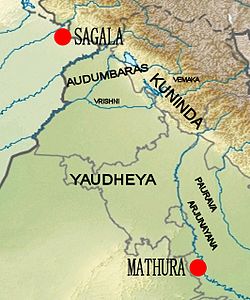Yaudheya | |||||||
|---|---|---|---|---|---|---|---|
| 5th century BCE–4th century CE | |||||||
Yaudheya coin, imitative of Kushan coinage, 3rd-4th centuries CE. Obverse: Karttikeya standing facing, holding a spear with dvi (“two” in Brahmi) to the left of Karttikeya's head, peacock to lower right, Brahmi legend around: 𑀬𑁅𑀥𑁂𑀬 𑀕𑀦𑀲𑁆𑀬 𑀚𑀬 (yaudheya ganasya jaya, “Victory to the Yaudheya people”). Reverse: Devasena standing left, raising hand; flower vase to left, inverted nandipada to the right.[1]
| |||||||
 Location of the Yaudheya relative to other groups: the Audumbaras, the Vemakas, the Vrishnis, the Kunindas, the Pauravas and the Arjunayanas | |||||||
| Capital | Rohtak | ||||||
| Government | Republic | ||||||
| History | |||||||
• Established | 5th century BCE | ||||||
• Disestablished | 4th century CE | ||||||
| |||||||
Yaudheya (Brahmi script: 𑀬𑁅𑀥𑁂𑀬) or Yoddheya Gana (Yoddheya Republic) was an ancient militant gana (confederation) based in the Eastern region of the Sapta Sindhu. The word Yaudheya is a derivative of the word from yodha meaning warriors[2][3] and according to Pāṇini, the suffix '-ya', was significant of warrior tribes,[4] which is supported by their resistance to invading empires such as the Kushan Empire and the Indo-Scythians.[5] Rudradaman I of the Western Satraps notes in his Junagadh rock inscription that the Yaudheyas were 'heroes among all Kshatriya' and 'were loath to surrender'. They were noted as having a republic form of government, unique from other Janapadas which instead maintained monarchies.[6]
- ^ Bajpai, K. D. (October 2004). Indian Numismatic Studies. Abhinav Publications. pp. 29–30. ISBN 978-81-7017-035-8.
- ^ “Yaudheyas.” Ancient Communities of the Himalaya, by Dinesh Prasad. Saklani, Indus Pub. Co., 1998, pp. 112–115.
- ^ Smith, V. (1897). Art. XXIX.—The Conquests of Samudra Gupta. Journal of the Royal Asiatic Society, 29(4), 859-910. doi:10.1017/S0035869X0002503X
- ^ Cunningham, Sir Alexander (1882). Report of a Tour in the Punjab in 1878-79. Office of the Superintendent of Government Printing. p. 140.
- ^ Majumdar, Ramesh Chandra; Altekar, Anant Sadashiv (1986). Vakataka gupta age: circa 200-550. Motilal Banarsidass Publ. pp. 28–30. ISBN 978-81-208-0026-7.
- ^ State & Government In Ancient India - A. S. Altekar. pp. 71–72.
© MMXXIII Rich X Search. We shall prevail. All rights reserved. Rich X Search

![Yaudheya coin, imitative of Kushan coinage, 3rd-4th centuries CE. Obverse: Karttikeya standing facing, holding a spear with dvi (“two” in Brahmi) to the left of Karttikeya's head, peacock to lower right, Brahmi legend around: 𑀬𑁅𑀥𑁂𑀬 𑀕𑀦𑀲𑁆𑀬 𑀚𑀬 (yaudheya ganasya jaya, “Victory to the Yaudheya people”). Reverse: Devasena standing left, raising hand; flower vase to left, inverted nandipada to the right.[1] of](http://upload.wikimedia.org/wikipedia/commons/thumb/3/3f/Post-Kushan_%28Yaudheya%29._Kushan_imitative._3rd-4th_centuries_CE.jpg/300px-Post-Kushan_%28Yaudheya%29._Kushan_imitative._3rd-4th_centuries_CE.jpg)